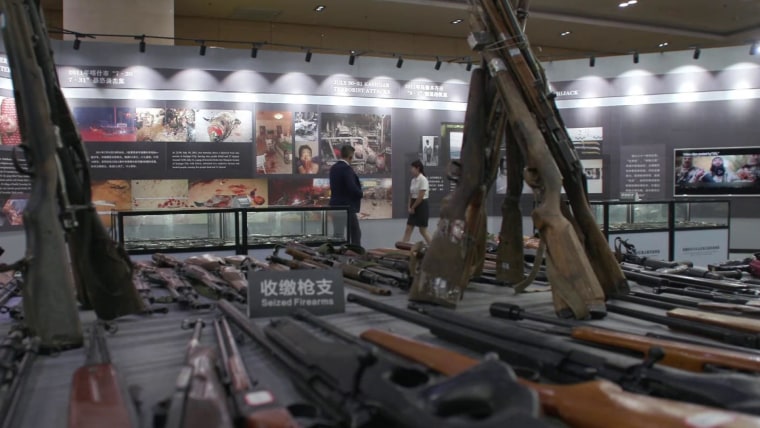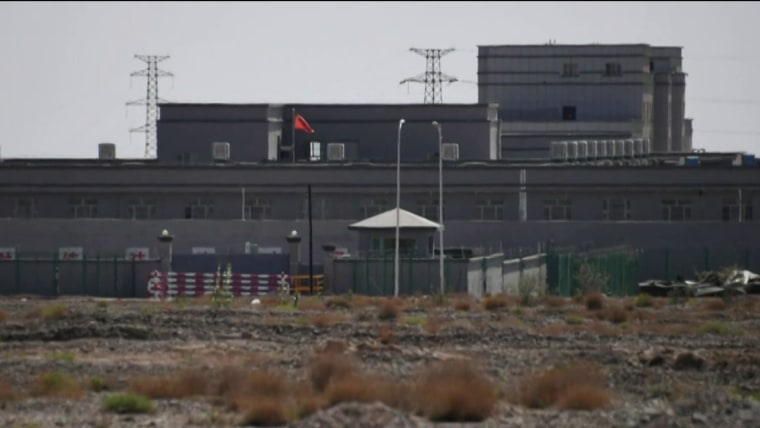The prevalence of torture and the lengths to which the Chinese government has gone to cover up its treatment of Muslim minorities are described in comprehensive detail in an Amnesty International report on detention camps in Western China.
Every former camp detainee Amnesty interviewed in the report recounted cruel and degrading treatment, including torture. The report, released Thursday, is based on interviews with 108 people, including 55 camp survivors and several government cadres who worked in the camps.
As part of an attempt to hide camp conditions from the world, Chinese officials created a massive, nearly week-long bonfire, burning as many documents as could be found from an office overseeing the camps, according to an ex-cadre who spoke to Amnesty and whose identity has been concealed for his safety.
The report also gives a behind the scenes look at the "tours" of the camps that the government gives to international journalists, which are meant to paint the facilities, which Chinese officials call "re-education camps," in a positive light.
The document burning occurred in 2019 following a leak of a trove of official Chinese government documents revealing the high-level organization and planning of the internment camps. They were published as part of a global reporting project led by the International Consortium of Investigative Journalists (ICIJ) that included NBC News.
A coordinated government effort to control information about the camps in the wake of the leak was first reported by the Associated Press.
The government cadre who said he attended the burning told Amnesty "it took five or six days to burn everything [in the office]. It was not only the [detainees'] files. It is any re-education–related materials. For example, all notes from meetings."
Chinese authorities in the western region of Xinjiang have been rounding up women and men — largely Muslims from the Uighur, Kazakh and Kyrgyz ethnic minorities — and detaining them in camps designed to rid them of terrorist or extremist leanings since 2017.
More than 1 million Uighurs and other minorities from Xinjiang are believed to be held in internment camps, where they are forced to study Marxism, renounce their religion, work in factories and face abuse, according to human rights groups and first-hand accounts. Beijing says these "re-education camps" provide vocational training and are necessary to fight extremism.
The Chinese Embassy in Washington did not respond to a request for comment.
One former detainee whose identity has been concealed for his safety told Amnesty he and others were coached for days on what to say to foreign journalists and even Chinese government delegations visiting from Beijing who were given camp tours.
"One day they told us journalists were coming," he said. "And that when you see them to smile. And to say what you were told or you will be taken to an underground room [where people are tortured]."
Amnesty conducted in-person interviews in Kazakhstan, Kyrgyzstan, and Turkey and remotely in several other countries in Asia, Europe, and North America. Forty-four of the 55 former detainees had never shared any part of their stories publicly before and their accounts represent a significant portion of all public testimonial evidence gathered about the situation inside the internment camps since 2017.
"The cover-up by the Chinese government is still ongoing," said the report's lead author Jonathan Loeb.
"The government has gone to extraordinary lengths to prevent people from leaving Xinjiang," he said, making the reporting of the story extremely difficult.
Given the risk of detention or disappearance for people who speak publicly about the human rights situation in Xinjiang, no interviews were conducted in Xinjiang either in person or remotely, according to Amnesty, and the identities of all witnesses were concealed.
The majority of the witnesses interviewed by Amnesty are Kazakh, a minority are Uighur and a small number are Kyrgyz or Han Chinese.
Every former detainee Amnesty interviewed was tortured or subjected to other cruel treatment during internment, according to the report.
Amnesty separated the torture or ill-treatment into two categories: that which took place as the results of daily life in the camps, and that which occurred during interrogations or as punishment for "misbehavior" by specific detainees.
Torture methods used during interrogations and as punishment included beatings, electric shocks, and stress positions, according to the report.
They also included sleep deprivation, being hung from a wall, or being locked in what's called a "tiger chair," a steel chair with affixed leg irons and handcuffs that render the body immobile, often in painful positions.
One former detainee told Amnesty he witnessed the torture of a cellmate who he believed was being punished for pushing a guard, and who was made to sit in a tiger chair in the middle of their cell, restrained and immobilized, for three days. He said he was expressly forbidden to help the man.
"Two [cuffs] were locked around his wrists and legs… A rubber thing attached to the ribs to make the person [sit] up straight… He would [urinate and defecate] in the chair…We told the guards. They said to clean him. His bottom was wounded. His eyes look unconscious," he is quoted as saying in the report.
The former detainee also told Amnesty he later learned the man had died in the camp.
World - Latest - Google News
June 10, 2021 at 10:00PM
https://ift.tt/3wfo99E
New details of torture, cover-ups in China's internment camps revealed in Amnesty International report - NBC News
World - Latest - Google News
https://ift.tt/2SeTG7d
https://ift.tt/35oCZy1
Bagikan Berita Ini



















0 Response to "New details of torture, cover-ups in China's internment camps revealed in Amnesty International report - NBC News"
Post a Comment